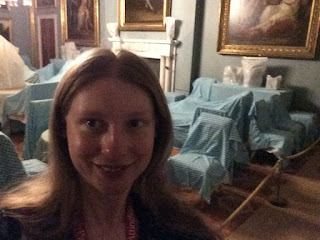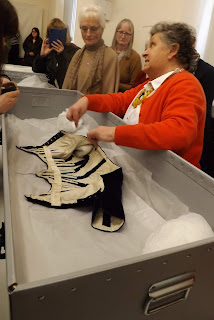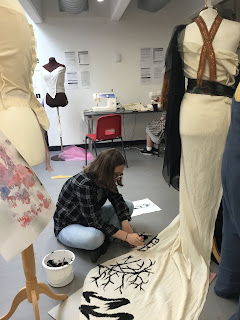Dorothy Wordsworth walked every day around the Lake District with her brother William and their friends, and then wrote about these walks in her journals. Dorothy and her friend Mary Barker were the first women to both climb and write about Scafell Pike. This walk was re-enacted in period dress by Dr Jo Taylor, Alex Jakob-Whitworth and Harriet Fraser in 2018 (exactly 200 years after Dorothy). I have been in contact with Dr Taylor from the University of Manchester as I was interested to discover how restrictive she found the period costume to be. Did it hinder her walking in any way? She told me: ‘We got caught in a storm that day on Scafell…The men, whose historical clothes were much more closely related to modern walking gear, wanted to go on – but wearing a long skirt is like wearing a kite; the women were being picked up, and it felt pretty hairy at some points to be blown quite significantly around the paths along some of the ridges.’
Figure 1
Corsets were another item of clothing which women wore and which restricted their movement. Figure 1 shows an advert for an ‘Athletic Girl Corset’. The development of special clothing for sport was an area of controversy as a passive lifestyle for women was seen to be more genteel. The design of female clothing was confining as rapid motion, ample waists and the raising of arms above the head were considered unfeminine so sleeves were cut to inhibit movement, corsets became tighter and petticoats more voluminous. Women’s clothing usually made them unable to engage in any activity more rigorous than a sedate stroll. So-called ‘walking dresses’ were part of a lady’s wardrobe from early nineteenth century, but their design permitted only the most leisurely of paces. In the mid-nineteenth-century, when outdoor exercise began to be more popular, women still wore ordinary clothing that interfered badly with their freedom of movement.
Figure 2
In the early 1850s, Amelia Bloomer tried to persuade women that beauty and utility in dress were not incompatible, and to adopt a form of Turkish trousers worn beneath a knee-length skirt (Figure 2). The bloomer costume was far too revolutionary for the time and the few brave women who wore them in public were ridiculed. The wire cage and crinoline introduced in the mid-1850s made walking in long skirts easier but expanding circumferences, sometimes to as much as 5 yards, impeded ease of motion. Dr Taylor experienced this problem first-hand on her re-enactment walk. The dresses of the 1870s and 1880s, with tied-back skirts and bustles, had smaller circumferences, but also a train that swept the ground and leg-of-mutton sleeves that restricted arm movement. In the 1890s, although daytime clothing was reduced in weight and complexity, ordinary skirts remained long, and ‘sensible’ walking outfits were 3.5 yards wide and hung to the ankle.1 During the Edwardian years, the reaction against the New Woman and her unconventional attitudes produced one of the most restrictive fashions of all time, the hobble skirt, whose exaggerated narrowness at the knee barely permitted a single step and more than offset the advantage of a slightly raised hemline (Figure 3).
Figure 3
One of the famous advocates for reform in women’s dress was Ada Ballin. She attacked ‘outmoded’ and ‘tyrannical’ ideas about dress.2 In relating health to dress and physical exercise she recounted the story of:
a Gentleman of scientific frame of mind, who determined to make the experiment of walking in petticoats in order to estimate the disadvantage under which women labored in regard to dress. He walked for a mile up a hill; but was so exhausted by the endeavor that he gave up with the remark that women must be stronger than men or they would never be able to stand it.3
Another advocate for dress reform was Martina Bergman-Österberg. She was a Swedish-born physical education instructor and women’s suffrage advocate. She advised against corsets and required functional dress for ordinary wear and exercise and advocated the wearing of gymslips for sport. Old students recalled that when going to matches they were called ‘those dreadful girls’ by ‘men who don’t know how troublesome skirts are and by women who don’t know how delicious it is to be free of them’.4
Figure 4
But what about when they got older and wanted to play sport professionally and in a public arena? Many women were successful mountaineers, but as this is a physical activity it must have been very difficult to participate in long, heavy dresses. For those who chose to wear dresses to climb, there were a range of possible skirt-related incidents to bear in mind. The Matterhorn’s Col Felicité was named after Felicité Carrel whose 1867 attempt at the summit with her father was thwarted when her skirts ballooned in the wind and it was too dangerous to go on. This is similar to the problems that Dr Taylor encountered on Scafell Pike. A common compromise was to wear a skirt or dress when leaving the hotel, then rip it off at the base of the mountain and climb in more sensible clothing. One woman who did just that was the Irish pioneer of mountaineering, Lizzie Le Blond (1860-1934). She set off on a traverse of the Rothorn, came down the other side and realized that her skirt was still on the summit. As the Alpine Club did not admit women members, she formed the Ladies’ Alpine Club in 1907. She moved to Switzerland, wrote seven books on mountaineering and made twenty first ascents, conquering peaks no one had climbed before. Abandoning mid-1880s convention, she was often known to climb in trousers. The Second President of Ladies’ Alpine Club was Lucy Walker. She was a British mountaineer and the first women to climb the Matterhorn – she was wearing a white print dress (Figure 4). Fanny Bullock Workman was an American mountaineer who climbed mainly in the Himalayas. She wore skirts whilst cycling thousands of miles across Europe and Asia, climbing peaks and negotiating crevasses. The photo shows her on Silver Throne Plateau (21,000 feet) holding a ‘Votes for Women’ newspaper (Figure 5). This clearly shows the link between walking and women’s independence.
Figure 5
Clothing has often hindered women’s freedom to exercise how they choose. Dress has restricted both women’s physical and social freedoms. By throwing off their corsets and finding more comfortable clothes to walk in, women had gained the independence to express themselves more freely in society.
1Kathleen E, McCrone, Sport and the Physical Emancipation of English Women, 1870-1914, (London: Routledge, 1988), p.217.
2Ballin, quoted in Cunnington and Mansfield, English Costume, (London, Faber, 1973), p.333.
3Ibid
4Ann Pagan, St. George's Chronicle, May 1894 quoted in May, Madame Bergman-Osterberg, (London: George G. Harrap & Co., 1969), p.45.
Naomi Walker, May 2020.
Special thanks to Dr Joanna Taylor from the University of Manchester for her helpful emails.






































